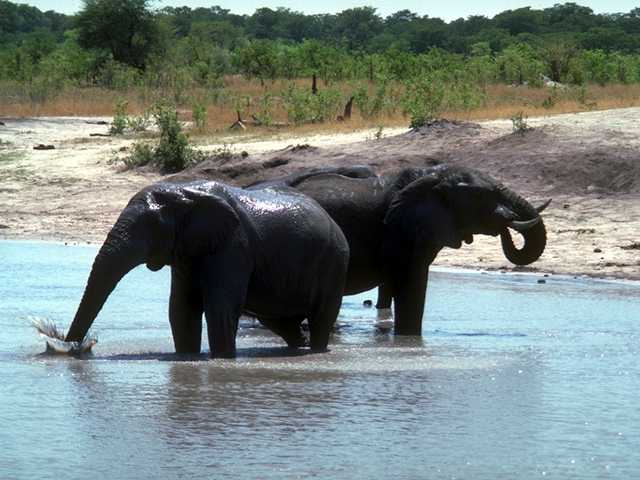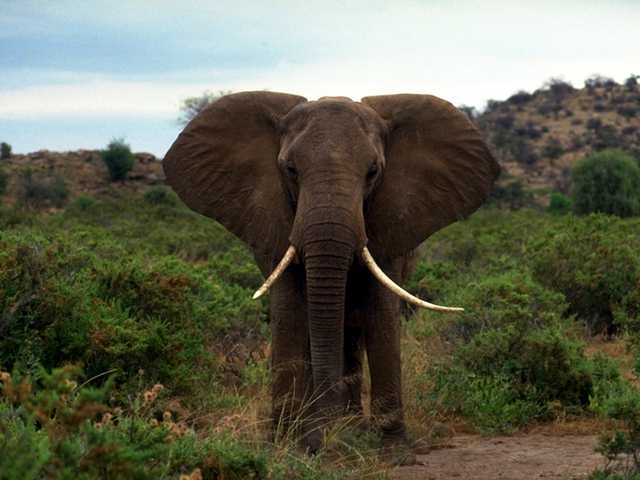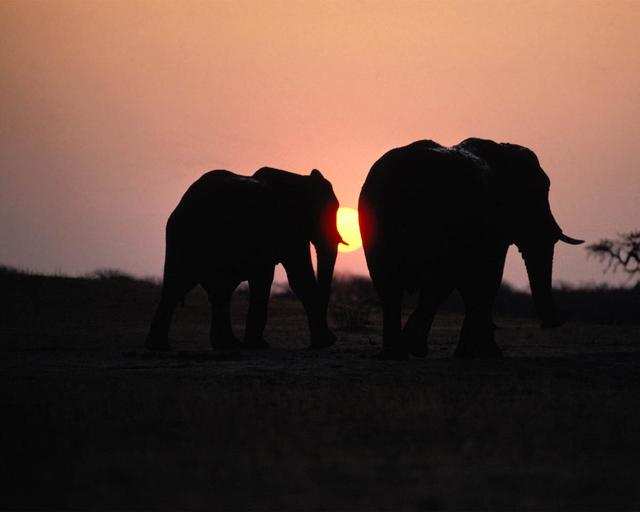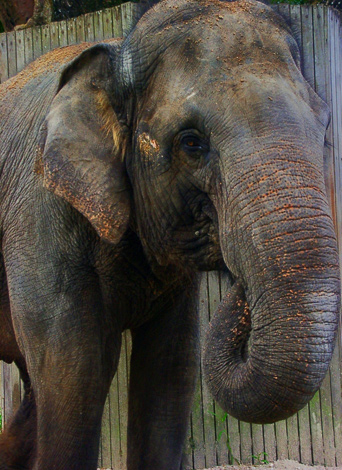|
Elephants

- Kingdom: Animalia
- Phylum: Chordata
- Subphylum:
Vertebrata
- Class: Mammalia
- Order: Proboscidea
- Family:
Elephantidae
The word "elephant"
has both Greek and Latin origins. This applies specifically to the elephant´s
scientific genus name "Elephas". In Greek linguistics, elephos represents an
antlered beast or stag. The roots of the word "elephant" in latin is divided
into two words; ele means arch and phant means huge. Also, the genus name
Loxodonta, for the African elephant means losenge-shaped teeth for the chewing
surfaces.

The modern-day
African and Asian elephants belong to the order Proboscideahas.The three living
species that exist today are: the African Bush (Savannah) Elephant, the African
Forest Elephant , and the Asian Elephant. In the past there were some 350
members in this order, but over time the majority of the members succumbed to
extinction. But, much like their predecessors, these species are
facing a grim future that is heading very near to another man-propelled
extinction.

Throughout history, the elephant
has played an important role in human economies, religion, and culture. The
immense size, strength, and stature of this largest living land animal has
intrigued people of many cultures for hundreds of years. In Asia, elephants have
served as beasts of burden in war and peace. Some civilizations have regarded
elephants as gods, and they have been symbols of royalty for some. Elephants
have entertained us in circuses and festivals around the world. For centuries,
the elephant's massive tusks have been prized for their ivory.
The African elephant once roamed
the entire continent of Africa, and the Asian elephant ranged from Syria to
northern China and the islands of Indonesia. These abundant populations have
been reduced to groups in scattered areas south of the Sahara and in isolated
patches in India, Sri Lanka, and Southeast Asia.

Demand for ivory, combined with
habitat loss from human settlement, has led to a dramatic decline in elephant
populations in the last few decades. In 1930, there were between 5 and 10
million African elephants. By 1979, there were 1.3 million. In 1989, when they
were added to the international list of the most endangered species, there were
about 600,000 remaining, less than one percent of their original number.
Asian elephants were never as
abundant as their African cousins, and today they are even more endangered than
African elephants. At the turn of the century, there were an estimated 200,000
Asian elephants. Today there are probably no more than 35,000 to 40,000 left in
the wild.
Elephants are considered a
keystone species in the African landscape. They pull down trees, break up
bushes, create salt licks, dig waterholes, and forge trails. Other animals,
including humans, like the pygmies of the Central African Republic, depend on
the openings elephants create in the forest and brush and in the waterholes they
dig.
Even elephant droppings are
important to the environment. Baboons and birds pick through dung for undigested
seeds and nuts, and dung beetles reproduce in these deposits. The nutrient-rich
manure replenishes depleted soil. Finally, it is a vehicle for seed dispersal.
Some seeds will not germinate unless they have passed through an elephant's
digestive system.
Elephant Anatomy
|
The
Feet
|
|
•
Elephants essentially walk on tiptoe because of the
way their feet are formed. A tough and fatty piece of connective tissue
forms the sole. |
| •The elastic,
spongy cushions on the bottom of elephant feet act as shock absorbers and
help elephants move silently. |
|
• Toes are buried inside the flesh of the foot and not all toes have
toenails. |
| • Africans
have four toenails on the front feet and three on the back; Asians have
five on the front and four on the back. |
|
• The circumference of the forefoot is equal to about half the shoulder
height. |
| • The pattern
of ridges and fissures left behind by an elephant footprint is as
distinctive as our fingerprints. |
|
• Front feet are more circularly formed, back feet are somewhat oval in
shape. |
| • Elongated
oval prints usually indicate an adult male. |
| |
|
The Trunk
|
|
• Elephants drink by filling their trunks with water and then pouring the
water into their mouths. |
| • African elephants have
two fingers on the tip of their trunks, Asians have only one finger and
typically use their trunks only to scoop objects up with.

|
|
Calves can lift about 4.5% of their own weight with their trunks. |
| • Elephants can
use their trunks for water storage, for sucking up mud and dust to cool off
with, and for friendly wrestling matches. |
|
• When elephants sense danger they will raise their trunks to smell any
threat. |
| • An elephant
charging with its trunk held high is generally bluffing. If the trunk is
tucked down, the elephant means business. |
| |
|
The Ears
• African elephant ears are at least three times the size of Asian
elephant ears.

|
|
African elephants use their ears as signaling devices and as protective
devices to ward off threats. |
|
• Ears are used to regulate
body temperature in both species. The elephants' surface area is small in
comparison to their total mass, making it difficult to release excess body
heat. Their large, veiny ears act like a radiator; when flapped, the blood
flowing through them is cooled, helping to regulate the elephants' body
temperature.

|
|
Every elephant’s ear is unique and is often used for identification purposes
(much like a fingerprint). |
| • Ear flaps are
made of cartilage with thin skin closely attached and are very soft and
sensitive. |
|
• Elephant ears have infrasound capabilities for long-range communication. |
Common Name
Scientific Name |
African Elephant
Loxondonata africana |
Asian Elephant
Elephas maximus |
Weight
Height
Tallest Point
Back
Belly
Head |
4-7 tons (8-14,000 lbs)
8-14 feet
Top of the shoulders
Concave
Slopes down from front to rear legs
1 rounded dome |
3-6 tons (6-12,000 lbs)
7-12 feet
Top of the head
Rounded
Level or slopes to the middle
2 domes |
Ears
|
Large, shaped like Africa |
Small and rectangular |
|
Tusks |
Male and female African elephants
have large tusks but the male's tusks
are larger and heavier |
Male's have large tusks, Females
have "tushes" which seldom extend
beyond the upper lip |
|
Trunk |
Tip has 2 finger-like projections |
Tip has 1 finger-like projections |
|
Skin |
Deeply wrinkled, sparse hair |
Lightly wrinkled, sparce hair |
African Elephants

Order:
Proboscidea
Family: Elephantidae
Genus and Species:
Loxodonta africana and L. cyclotis
The world's largest living land mammals are best known for their huge size,
unique body parts, social behavior, and longevity.
-
Physical Description:
Two African elephant species are recognized: the larger and more
widespread savanna elephant (L. africana) and
the forest elephant (L. cyclotis), which is
smaller, has downward-pointed tusks, and smaller, rounder ears. Some genetic
evidence suggests there may be a third species, the west African elephant,
intermediate to these two. The animals' trunks, unique among living mammals,
are versatile, enabling elephants to manipulate tiny objects or tear down
huge tree limbs. Wide, padded feet enable elephants to walk quietly. Large,
flappable ears help these huge animals to cool off, although elephants often
must retreat to the shade or water during the hottest part of the day.
-
Size:
Male African elephants of the savanna species grow up to 25 feet long,
stand up to 11 feet tall and weigh up to 14,000 pounds. Males are usually
larger than females.
-
Geographic Distribution: African elephants live in many parts of
sub-Saharan Africa, although their range is now broken into patches. Small
numbers of forest elephants live in dense equatorial forests of Central
Africa from Zaire west to Mauritania, while savanna elephants are far more
widespread in drier woodlands and savannas. Savanna elephants are now most
common in Kenya, Tanzania, Botswana, Zimbabwe, Namibia, and South Africa.
The suspected third species lives in both savanna and forest in west Africa.
-
Status:
African elephants are listed as endangered on the World Conservation
Union's Red List of Threatened Animals.
-
Habitat:
African elephants live wherever they can find enough food and water with
minimal disturbance from people. Most of the continent's elephants live on
savannas and in dry woodlands. In some regions, they occur in desert areas;
in others, they are found in mountains. In Congo and other equatorial
countries, forest elephants live in dense tropical rainforest.
-
Natural Diet: A dexterous trunk and large, rasping molars allow
African elephants to gather and process a wide variety of vegetation. During
the rainy season, savanna elephants usually seek out grasses and herbs.
During other times of year, they frequent forests, especially those by
streams, where they also eat leaves, fruit, and bark from a variety of
plants. Elephants supplement the sodium in their food by visiting mineral
licks.
-
Reproduction:
Older and larger males—especially those in musth (condition of heightened
testosterone levels)—dominate the breeding, winning the acceptance of
females in heat. Gestation lasts 22 months, and usually only one calf is
born. Female African savanna elephants can usually breed by age ten and give
birth to one young every four years.
-
Life Span: The average life span of an African savanna elephant
in the wild is 60 years.
-
Behavior:
Females and young males live in cohesive herds of about ten related
adults and their offspring. The matriarch, usually the oldest and largest
female, sets the pace of the group's activities. Males leave herds at
puberty, around their 13th year, and travel alone or in bachelor groups.
Elephants travel widely in search of food. Movements vary depending upon
food availability. African elephants communicate with rumbles, growls,
bellows, and moans. Some of these varied, low-frequency sounds may travel a
mile or more.

Asian Elephants

Order: Proboscidea
Family: Elephantidae
Genus and Species: Elephas maximus
Giant herbivores, Asian elephants can tear down huge tree limbs or pick up small
objects with their muscular trunks.
-
Physical Description: Asian elephants are huge gray animals
inhabiting Asian tropical forests. Their gray coloration conceals them in
their shady habitat. Elephants' trunks, unique among living mammals, are
versatile, enabling them to reach the ground, manipulate tiny objects or
tear down huge tree limbs, squirt water over their backs or into their
mouths, or blow dirt onto their backs during dust baths. Female Asian
elephants usually lack visible tusks as do males in some populations, such
as those in northeast India. Wide, padded feet enable them to walk quietly.
Large, flappable ears help these huge animals cool off, although elephants
often must retreat to the shade or water during the hottest part of the day.
-
Size:
Asian elephants grow up to 21 feet long, stand up to 10 feet tall, and
weigh up to 11,000 pounds. Females reach around eight and a half feet tall
and weigh less than males. Despite their size, elephants are able to walk
silently.
-
Geographic Distribution: Asian elephants live in large blocks of
forest near water sources and grasslands, habitat that has been greatly
reduced in the last half century. They inhabit India, Sri Lanka, Myanmar
(Burma), Indonesia, Thailand, Cambodia, Vietnam, Laos, Malaysia, Nepal,
Bangladesh, and southern China.
-
Status:
The Asian elephant is listed as endangered on the World Conservation Union's
(IUCN's) Red List of Threatened Animals.
-
Habitat:
Asian elephants inhabit a variety of tropical forest habitats from moist,
evergreen lowland forest to dry semi-deciduous teak forests to cooler
mountain forests up to 10,000 feet. They also frequent adjacent grasslands
and farm areas. Their varied diet enables them to live in disturbed forests
as long as they have plenty of space to move around and exploit different
foods without coming into conflict with people.
-
Natural Diet: A dexterous trunk and large, rasping molars allow
Asian elephants to gather and process a wide variety of vegetation,
including grasses and herbs, leaves, fruit, farm crops, and bark.
-
Reproduction:
Older and larger males—especially those in musth (condition of
heightened testosterone levels) dominate the breeding, winning the
acceptance of females in heat. Gestation takes 20 to 22 months, and usually
only one calf is born. Female Asian elephants can usually breed by age 14
and usually give birth to one young every four years.
-
Life Span: In the wild, Asian elephants may live up to about 60
years but most do not live that long.
-
Behavior:
Female and young male Asian elephants live in cohesive herds of related
adults and their offspring. The matriarch, usually the oldest and largest
female, sets the pace of the group's activities. Herds often join with
others to form large groups called clans. Males leave herds at puberty,
around their 13th year, and travel alone or in bachelor groups. Elephants
wander widely in search of food. Movements vary widely depending upon food
availability. Asian elephants communicate via rumbles, growls, bellows, and
moans. Some of these varied, low-frequency sounds may travel a mile or more.
Causes of
Endangerment
Habitat
Loss
Elephants need a large amount of
habitat because they eat so much. Humans have become their direct competitors
for living space. Human populations in Africa and Asia have quadrupled since the
turn of the century, the fastest growth rate on the planet. Forest and savanna
habitat has been converted to cropland, pastureland for livestock, and timber
for housing and fuel.
Humans do not regard elephants as
good neighbors. When humans and elephants live close together, elephants raid
crops, and rogue elephants (aggressive male elephants during the breeding
season) rampage through villages. Local people shoot elephants because they fear
them and regard them as pests. Some countries have established culling programs:
park officials or hunters kill a predetermined number of elephants to keep herds
manageable and minimize human-elephant conflicts.
Overexploitation
Hunting has been a major cause of
the decline in elephant populations. Elephants became prized trophies for
big-game hunters after Europeans arrived in Africa. More recently, and more
devastatingly, hunters have slaughtered elephants for their ivory tusks. The
ivory trade became a serious threat to elephants in the 1970s. A sudden oil
shortage caused the world economy to collapse, and ivory became more valuable
than gold. In fact, ivory has been called "white gold" because it is beautiful,
easily carved, durable, and pleasing to the touch. Most of the world's ivory is
carved in Japan, Hong Kong, and other Asian countries, where skilled carvers
depend on a supply of ivory for their livelihoods.

Hunting elephants is no longer
legal in many African countries. For many the high price of ivory is too
tempting to resist. Local people often had few other ways to make a living, and
subsistence farmers or herders could make more by selling the tusks of one
elephant than they could make in a dozen years of farming or herding.
As the price of ivory soared,
poachers became more organized, using automatic weapons, motorized vehicles, and
airplanes to chase and kill thousands of elephants. To governments and
revolutionaries mired in civil wars and strapped for cash, poaching ivory became
a way to pay for more firearms and supplies.
Poaching has caused the collapse
of elephants' social structure as well as decimating their numbers. Poachers
target the biggest elephants because their tusks are larger. They often kill all
the adults in the group, leaving young elephants without any adults to teach
them migration routes, dry-season water sources, and other learned behavior.
Many of Africa's remaining elephant groups are leaderless subadults and
juveniles.
-
Large-scale seizures of ivory (consignments of over 800 kg) destined for
Asia have more than doubled since 2009 and reached an all-time high in
2011.
- Large
movements of ivory that comprise the tusks of hundreds of elephants in a
single shipment are indicative of the increasingly active grip of highly
organized criminal networks on Africa’s illicit ivory trade.
- These
criminal networks operate with relative impunity as there is almost no
evidence of successful arrests, prosecutions or convictions.
-
Globally, illegal ivory trade activity has more than doubled since 2007,
and is now over three times larger than it was in 1998.
- The
prevalence of unregulated domestic ivory markets in many African cities,
coupled with the growing number of Asian nationals residing in Africa
also facilitates the illegal trade in ivory out of Africa.
- Poaching
is spreading primarily as a result of weak governance and rising demand
for illegal ivory in the rapidly growing economies of Asia, particularly
China, which is the world’s largest destination markets.
- The high
levels of poaching are, in some cases, facilitated by conflicts that,
through lawlessness and ensuing abundance of small arms, provide optimal
conditions for the illegal killing of elephants.



|













